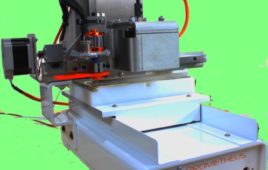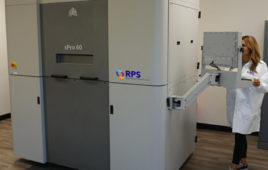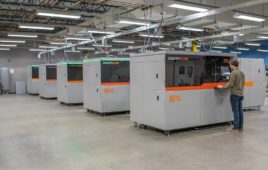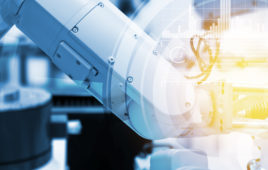Electric motorcycles aren’t new, but if you add a shell and a self-balancing system, that’s a whole different animal. Lit Motors is not only looking to improve the carbon footprint of vehicles, the company is looking to reinvent the way we look at two-wheeled road hogs.
After a near-death experience, Lit Motors’ founder, Danny Kim, was inspired to create a new vehicle platform that mixed elements of both cars and motorcycles. Lit Motors Chief Marketing Officer Ryan James explains, “A lifelong DIY’er, Danny was in the middle of a project to create the perfect SUV. He stripped two Land Rover Defenders to the frame and redesigned, re-engineered, and rebuilt both. Late one night, Danny was working on a creeper underneath a 500-lb chassis, welding additional pieces to it. The stands holding the chassis failed, and Danny narrowly escaped being crushed.”
As Kim pondered the near miss, he “thought about how Americans move around as compared with people in Europe, Asia, and South America.” James says, “Outside of the U.S., two-wheelers rule the road, but Americans love cars and there are real safety concerns with motorcycles and scooters. That led him to the idea of combining the best of both worlds.”
It Isn’t a Motorcycle
Lit Motors doesn’t consider the C-1 a motorcycle, even though it can weave in traffic and park in motorcycle-designated spaces. “Like a motorcycle, the C-1 is both spatially and energy efficient,” explains James. The Scandinavian influenced design has a light weight frame, which in combination with finely tweaked aerodynamics, make it the most efficient consumer vehicle on the road, according to the company.
The C-1 utilizes a drive-by-wire steering system, so though it sits like a motorcycle, the driver uses a steering wheel for navigation. Like a motorcycle, a passenger has to sit behind the driver, but both riders have airbags.
Keeping the Balance
Arguably, the most revolutionary component to Lit Motors’ electric motorcycle-car hybrid is the self-righting capability. With the help of a gyro stability system, the C-1 simply won’t tip over. “Our stabilizing system uses control moment gyroscopes (CMGs) typically found in satellites and spacecraft,” James says. “Unlike other gyro-stabilized vehicles, these flywheels exert real force, and can therefore actively resist outside forces to control the tilt/lean of the C-1.”
The C-1 uses a pair of CMGs that counter-rotate and counter-precess, and they are controlled by the vehicle via actuated gimbals. “The C-1 then uses an array of sensors and smartphone-like computing power to hold itself upright at low speeds and when stopped,” explains James.
As part of the drive-by-wire steering, the system allows the vehicle to lean in and out of turns like a normal motorcycle. Using the information from its array of sensors, the C-1 determines everything from road surface conditions to wind. The vehicle incorporates that information with driver commands – steering, braking, acceleration, etc. – and converts it into movement of the front wheel and lean angle.
Drive & Power
This two-wheeler is also all electric. Aiming for efficiency, the designers incorporated a custom Li-ion pack that they developed themselves. “Sourcing the cells themselves is quite easy; and with a vehicle as unique as the C-1, we knew a custom pack would be required,” James says. “We prefer to keep things in-house rather than outsource, so we’re micro-welding our own custom battery packs. It’s cheaper and gives us more control over the end product.”
Thanks to a modular design incorporated throughout the vehicle, the battery can be easily upgraded as new technology comes to market. Like many EVs, the C-1 uses an onboard charger that plugs into any standard (120 V) outlet, and is good for up to 200 miles with six hours of charging.
The custom battery pack powers direct drive, in-hub motors on both wheels to propel the C-1 down the road at a top speed of more than 100 mph. The motors generate energy while braking, using a KERS (kinetic energy recovery system) to store the energy kinetically in the gyro flywheels, and supplement the 10 kWh battery pack.
Constant Development
The C-1 is already up for preorder on the company’s website and the team is preparing for production, but the design didn’t happen overnight. “Our design philosophy involves rapid iteration, generating as many ideas as possible and then paring those down,” James explains. After several iterations the basic concept of a self-balancing, two-wheeled, two-person vehicle has held steady, though the team plans to continue development.
“The biggest challenge – and part of the fun – is that nothing even remotely like the C-1 exists, so there are few off-the-shelf parts we can use,” says James. “Almost everything is custom-made. However, we’re an extremely hands-on company, so making everything is just part of the fun.”
The company is currently developing the next C-1 prototype with a plan to unveil it later this spring, since the first production run is already 85% presold. “We’re concentrating on California and the U.S. for now, but we plan to expand and take the C-1 worldwide as quickly as possible,” he says. “The C-1 is not a one-off vehicle, but a new vehicle platform; we’ll develop many different models in the future.”
With a car-like interface coupled with the freedom and size of a motorcycle, this two-wheeler is looking to break the mold of vehicle platforms for generations.
Filed Under: Rapid prototyping




